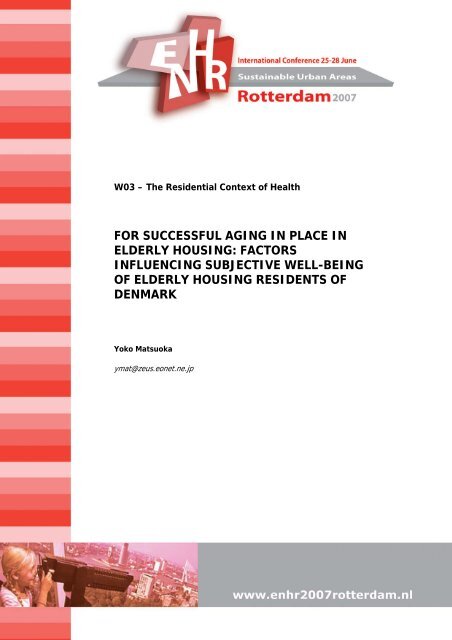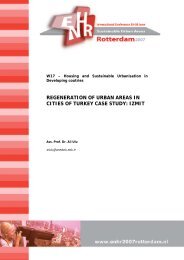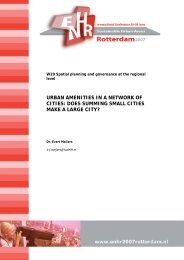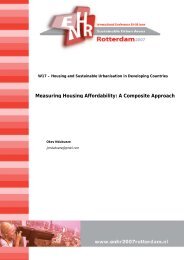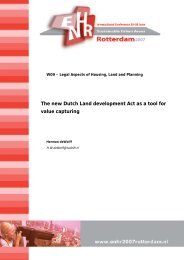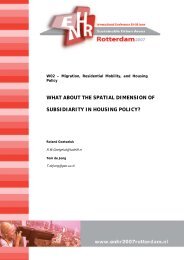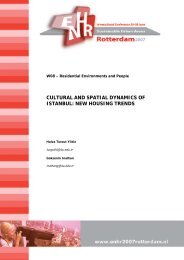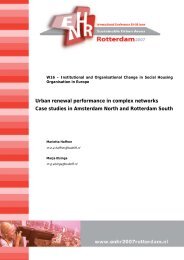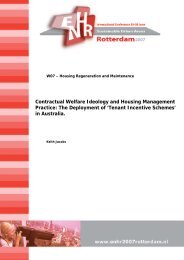for successful aging in place in elderly housing - ENHR 2007 ...
for successful aging in place in elderly housing - ENHR 2007 ...
for successful aging in place in elderly housing - ENHR 2007 ...
Create successful ePaper yourself
Turn your PDF publications into a flip-book with our unique Google optimized e-Paper software.
W03 – The Residential Context of Health<br />
FOR SUCCESSFUL AGING IN PLACE IN<br />
ELDERLY HOUSING: FACTORS<br />
INFLUENCING SUBJECTIVE WELL-BEING<br />
OF ELDERLY HOUSING RESIDENTS OF<br />
DENMARK<br />
Yoko Matsuoka<br />
ymat@zeus.eonet.ne.jp
For <strong>successful</strong> <strong>ag<strong>in</strong>g</strong> <strong>in</strong> <strong>place</strong> <strong>in</strong> <strong>elderly</strong> hous<strong>in</strong>g: Factors <strong>in</strong>fluenc<strong>in</strong>g subjective well-be<strong>in</strong>g of the <strong>elderly</strong> hous<strong>in</strong>g residents of<br />
Denmark<br />
<strong>ENHR</strong> <strong>2007</strong> International Conference ‘Susta<strong>in</strong>able Urban Areas’<br />
For Successful Ag<strong>in</strong>g <strong>in</strong> Place <strong>in</strong> Elderly Hous<strong>in</strong>g:<br />
Factors Influenc<strong>in</strong>g Subjective Well-be<strong>in</strong>g of Elderly Hous<strong>in</strong>g<br />
Residents of Denmark<br />
Yoko Matsuoka, JAPAN<br />
School of Sociology<br />
Kwansei Gaku<strong>in</strong> University, ymat@zeus.eonet.ne.jp<br />
Phone +81-798-73-1011 / fax +81-798-73-1063<br />
Abstract:s:<br />
Elderly hous<strong>in</strong>gs are the key accommodations <strong>for</strong> <strong>ag<strong>in</strong>g</strong> <strong>in</strong> <strong>place</strong> that provide<br />
physically supportive environment, such as no steps (barrier-free), wide toilet to help<br />
self-help and convenient surround<strong>in</strong>gs to live <strong>in</strong>dependently <strong>for</strong> the <strong>elderly</strong> with a little<br />
physical frailty. In Denmark, they stopped build<strong>in</strong>g new nurs<strong>in</strong>g homes <strong>in</strong> 1988 and<br />
started build<strong>in</strong>g <strong>elderly</strong> hous<strong>in</strong>gs where the residents can live <strong>in</strong>dependently as long as<br />
possible with gett<strong>in</strong>g community-based 24 hours care flexibly as they get more weak.<br />
This study presents results of research based on data from <strong>in</strong>terviews with 15 residents<br />
<strong>in</strong> 3 <strong>elderly</strong> hous<strong>in</strong>gs <strong>in</strong> Denmark and from quantitative survey with 62 <strong>elderly</strong> persons<br />
liv<strong>in</strong>g <strong>in</strong> a <strong>elderly</strong> hous<strong>in</strong>g. The author found out through correlations and regression<br />
analysis that possibility of residential cont<strong>in</strong>uation and satisfaction of the hous<strong>in</strong>g and<br />
<strong>in</strong>dependent attitude from medical care and extroversion and action of gett<strong>in</strong>g<br />
out/meet<strong>in</strong>g someone have strongest relationship with subjective well-be<strong>in</strong>g among<br />
other factors such as age, economic condition and health condition <strong>in</strong>clud<strong>in</strong>g behavioral<br />
competence. Results show dist<strong>in</strong>ctive profile of needs and resources concern<strong>in</strong>g<br />
hous<strong>in</strong>g condition and flexible community-based care and social <strong>in</strong>teraction and less<br />
dependence on medical care.<br />
Keywords: Denmark; <strong>elderly</strong> hous<strong>in</strong>g; subjective well-be<strong>in</strong>g; <strong>ag<strong>in</strong>g</strong> <strong>in</strong> <strong>place</strong>; live <strong>in</strong>dependently<br />
Workshop: 3 The residential Context of Health<br />
Author: Yoko Matsuoka<br />
1
For <strong>successful</strong> <strong>ag<strong>in</strong>g</strong> <strong>in</strong> <strong>place</strong> <strong>in</strong> <strong>elderly</strong> hous<strong>in</strong>g: Factors <strong>in</strong>fluenc<strong>in</strong>g subjective well-be<strong>in</strong>g of the <strong>elderly</strong> hous<strong>in</strong>g residents of<br />
Denmark<br />
1. Introduction<br />
“Ag<strong>in</strong>g <strong>in</strong> <strong>place</strong>” refers to the trend whereby older persons are “liv<strong>in</strong>g <strong>in</strong> their own<br />
residences and communities as long as possible, despite <strong>in</strong>creas<strong>in</strong>g frailty and its associated<br />
problems” (Ivry, 1995), and is regarded as effective to delay or even avoid relocation to a<br />
nurs<strong>in</strong>g home.<br />
When older people get frail, the liv<strong>in</strong>g environment needs to be more supportive to<br />
compensate <strong>for</strong> their limitations or disabilities. In this context, <strong>elderly</strong> hous<strong>in</strong>g is the key<br />
accommodation that provide physically supportive environment such as no steps (barrierfree),<br />
wide toilet to help self-help and convenient surround<strong>in</strong>gs to live <strong>in</strong>dependently <strong>for</strong> the<br />
<strong>elderly</strong> with a little physical frailty. Both from the elders’ quality of life po<strong>in</strong>t of view and the<br />
po<strong>in</strong>t of f<strong>in</strong>ancial matter of policy makers, <strong>elderly</strong> hous<strong>in</strong>g <strong>for</strong> <strong>ag<strong>in</strong>g</strong> <strong>in</strong> <strong>place</strong> is <strong>for</strong>efront<br />
issue.<br />
Generally speak<strong>in</strong>g, European countries provide these k<strong>in</strong>ds of hous<strong>in</strong>gs <strong>for</strong> the <strong>elderly</strong> at rate<br />
of around 5% of the <strong>elderly</strong> 65 years old over (OECD, 2000). Especially, Denmark is one of<br />
the countries with highest rate of <strong>elderly</strong> hous<strong>in</strong>g provision. Most of all, the country took<br />
peculiar strategy to achieve <strong>ag<strong>in</strong>g</strong> <strong>in</strong> <strong>place</strong> after de<strong>in</strong>stitutionalization at 1988. That is the<br />
separation theory of service function from dwell<strong>in</strong>g function, on the contrary the <strong>in</strong>stitutions<br />
are dwell<strong>in</strong>gs packaged with care where the <strong>elderly</strong> lose their liv<strong>in</strong>g power and self-dignity<br />
under provider-oriented attitude (Hansen, 1998; Andersen, 1995; Matsuoka, 2005).<br />
In this paper, the focus is <strong>place</strong>d on the factors <strong>in</strong>fluenc<strong>in</strong>g the subjective well-be<strong>in</strong>g of the<br />
residents <strong>in</strong> <strong>elderly</strong> hous<strong>in</strong>g <strong>in</strong> Denmark, and the strongest factors which were searched<br />
though <strong>in</strong>terview survey are found out though multi-variable regression analyses.<br />
This study is <strong>place</strong>d as pre-survey followed by big scale research <strong>in</strong> Denmark and Japan.<br />
2. Review of the Literature<br />
Ag<strong>in</strong>g <strong>in</strong> <strong>place</strong><br />
Traditionally the term “<strong>ag<strong>in</strong>g</strong> <strong>in</strong> <strong>place</strong>” has referred to <strong>in</strong>dividuals grow<strong>in</strong>g old <strong>in</strong> their own<br />
homes with the emphasis on modification of home environments to compensate <strong>for</strong><br />
limitations and disabilities (Pynoos, 1993). Ag<strong>in</strong>g <strong>in</strong> <strong>place</strong> is the newer term to be <strong>in</strong>cluded<br />
along with ‘senior citizen’ ‘golden agers’ <strong>in</strong> the lexicon of gerontology (Callahan, 1993). To<br />
achieve this trend, two elements are required. One is community/home-based service, and the<br />
other is the accommodation (Ivry, 1995).<br />
It is social reality that the <strong>elderly</strong> stay <strong>in</strong> their home or <strong>in</strong> <strong>elderly</strong> hous<strong>in</strong>g with associat<strong>in</strong>g<br />
with their decl<strong>in</strong><strong>in</strong>g function. The development of the house-related services and communitybased<br />
care can enable the <strong>elderly</strong> to age <strong>in</strong> <strong>place</strong> (Ivry, 1995).<br />
Accommodation has implications of shelter and dynamic environment which is adapted to<br />
physical change of the residents and to comprehensive social condition (Kelen & Griffiths,<br />
1983). Although most older persons prefer to age <strong>in</strong> <strong>place</strong> at home, few argued this po<strong>in</strong>t.<br />
Recently the concept has been expanded to <strong>in</strong>clude <strong>elderly</strong> hous<strong>in</strong>g (Ball, 2004). Ball takes<br />
“assisted liv<strong>in</strong>g” <strong>in</strong> United States as example, a type of midrange supportive hous<strong>in</strong>g<br />
generally considered less restrictive and more home-like than nurs<strong>in</strong>g home. Elderly hous<strong>in</strong>g<br />
as alternative of own home is the effective and suitable shelter <strong>for</strong> <strong>ag<strong>in</strong>g</strong> <strong>in</strong> <strong>place</strong>.<br />
Ag<strong>in</strong>g <strong>in</strong> <strong>place</strong> <strong>in</strong> Denmark<br />
S<strong>in</strong>ce 1998, Build<strong>in</strong>g new nurs<strong>in</strong>g homes “Plejehjem” have been prohibited. Instead of<br />
<strong>in</strong>stitutions, they have built <strong>elderly</strong> hous<strong>in</strong>gs “Ælderboliger (Almene ælderboliger)” with help<br />
of various policies to promote <strong>ag<strong>in</strong>g</strong> <strong>in</strong> <strong>place</strong>. As described <strong>in</strong> <strong>in</strong>troduction, the separation<br />
theory of dwell<strong>in</strong>g and services made this movement peculiar. The older persons can age <strong>in</strong><br />
2<br />
Workshop: 3 The residential Context of Health<br />
Author: Yoko Matsuoka
For <strong>successful</strong> <strong>ag<strong>in</strong>g</strong> <strong>in</strong> <strong>place</strong> <strong>in</strong> <strong>elderly</strong> hous<strong>in</strong>g: Factors <strong>in</strong>fluenc<strong>in</strong>g subjective well-be<strong>in</strong>g of the <strong>elderly</strong> hous<strong>in</strong>g residents of<br />
Denmark<br />
<strong>place</strong> <strong>in</strong> <strong>elderly</strong> hous<strong>in</strong>g to get community-based care flexibly as they are gett<strong>in</strong>g more and<br />
more frail or handicapped.<br />
“Elderly/person with handicap law” prescribes about the condition of the <strong>elderly</strong> hous<strong>in</strong>g<br />
simply and accurately. It must be no steps structure, under 67 square meters wide, selfconta<strong>in</strong>ed<br />
house, accessible, can get help round-clock. The purpose of the <strong>elderly</strong> hous<strong>in</strong>g is<br />
to help the <strong>elderly</strong> or the handicapped live <strong>in</strong>dependently <strong>in</strong> common and suitable<br />
environment.<br />
About 5.5 % of the <strong>elderly</strong> 65 years old over live <strong>elderly</strong> hous<strong>in</strong>g ( Matsuoka, 2005).<br />
Factors <strong>in</strong>fluenc<strong>in</strong>g of subjective well-be<strong>in</strong>g <strong>in</strong> <strong>elderly</strong> hous<strong>in</strong>g<br />
Lawton composed Quality of life with four doma<strong>in</strong>s, psychological well-be<strong>in</strong>g, perceived<br />
QOL, behavioural competence, objective environment ( Lawton, 1983). In recent years,<br />
considerable debate has addressed the issue of how to def<strong>in</strong>e the concept of quality of life,<br />
particularly as it relates to frail elders. Although no precise def<strong>in</strong>ition has emerged,<br />
<strong>in</strong>vestigators generally agree that the construct is multidimensional and has both subjective<br />
and objective components (Birren & Dieckmann, 1991; Ball, 2000).<br />
This study focuses on the issue concern<strong>in</strong>g well-be<strong>in</strong>g of the residents <strong>in</strong> <strong>elderly</strong> hous<strong>in</strong>g.<br />
The previous studies of quality of life <strong>in</strong> <strong>elderly</strong> hous<strong>in</strong>g, <strong>in</strong>clud<strong>in</strong>g <strong>in</strong>stitutions, are quite few.<br />
And the def<strong>in</strong>itions of quality of life <strong>in</strong> <strong>elderly</strong> hous<strong>in</strong>g vary so much about the component<br />
construction. Ball said that these few studies <strong>in</strong>dicate the needs <strong>for</strong> additional <strong>in</strong><strong>for</strong>mation<br />
about how residents def<strong>in</strong>e quality of life and the factors <strong>in</strong> the social and physical<br />
environment of the sett<strong>in</strong>g that <strong>in</strong>fluence it (2000). She identified 14 doma<strong>in</strong>s of quality of<br />
life based on the comb<strong>in</strong>ed values expressed by residents <strong>in</strong> <strong>in</strong>terview data. Doma<strong>in</strong>s <strong>in</strong>clude<br />
aspect specifically related to quality of care as well as components of the broader concept. 14<br />
doma<strong>in</strong>s are, psychological well-be<strong>in</strong>g, <strong>in</strong>dependence and autonomy, social relationships and<br />
<strong>in</strong>teractions, mean<strong>in</strong>gful activities, care from facility, com<strong>for</strong>t, cognitive function<strong>in</strong>g/memory,<br />
sleep, food, connectedness to community out side of facility, physical function<strong>in</strong>g,<br />
religion/spirituality, physical environment, safety and security.<br />
All these studies made clear the concept components of quality of life. But, it is not clear<br />
what is <strong>in</strong>dependence, autonomy, safety and security and so on.<br />
So, the purpose of this study is to make clear the contents of factors <strong>in</strong>fluenc<strong>in</strong>g subjective<br />
well-be<strong>in</strong>g through qualitative survey and to demonstrate which factors are more effective to<br />
promote well-be<strong>in</strong>g of the residents through quantitative survey and multi-variable regression<br />
analyses.<br />
3. Research design and methodology<br />
The ma<strong>in</strong> purpose of this focused <strong>in</strong>vestigation is to discover and exam<strong>in</strong>e what k<strong>in</strong>d of<br />
factors are the most effective <strong>for</strong> Danish <strong>elderly</strong> to live <strong>in</strong> <strong>elderly</strong> hous<strong>in</strong>g with high wellbe<strong>in</strong>g.<br />
In this research, the factors are searched by qualitative survey at first, and then the<br />
searched factors are exam<strong>in</strong>ed by correlations and regression analyses.<br />
Interview and grounded theory analyses<br />
The 15 residents <strong>in</strong> three <strong>elderly</strong> hous<strong>in</strong>gs, Ælderboliger, was <strong>in</strong>terviewed follow<strong>in</strong>g<br />
<strong>in</strong>terview guide. Participants were recruited by the leader of day centre which is located next<br />
to the <strong>elderly</strong> hous<strong>in</strong>g. The distribution of the age was 62 to 99. The number of those<br />
between 62-69 was 3, 70-79 was 6, 80-89 was 4, over 90 was 2. 13 out of 15 were s<strong>in</strong>gle.<br />
The almost <strong>in</strong>terviews were done at the day centre except 4 at their own houses. The<br />
<strong>in</strong>terview guide l<strong>in</strong>e was consisted of three essential theme : 1) How do you feel liv<strong>in</strong>g here?<br />
2) Would you tell me precisely about what is good/happy and what is problem/unhappy here?<br />
3) What do you want most strongly liv<strong>in</strong>g here now and from now on? Their profile, age,<br />
Workshop: 3 The residential Context of Health<br />
Author: Yoko Matsuoka<br />
3
For <strong>successful</strong> <strong>ag<strong>in</strong>g</strong> <strong>in</strong> <strong>place</strong> <strong>in</strong> <strong>elderly</strong> hous<strong>in</strong>g: Factors <strong>in</strong>fluenc<strong>in</strong>g subjective well-be<strong>in</strong>g of the <strong>elderly</strong> hous<strong>in</strong>g residents of<br />
Denmark<br />
family type, period of the residence, the process of mov<strong>in</strong>g <strong>in</strong>to the <strong>elderly</strong> hous<strong>in</strong>g was asked.<br />
Whole contents of <strong>in</strong>terview were recorded by a recorder and wrote down <strong>in</strong>to text data <strong>for</strong><br />
follow<strong>in</strong>g analyses.<br />
The reason <strong>for</strong> tak<strong>in</strong>g grounded theory analysis is that <strong>for</strong> the first, this research is deal<strong>in</strong>g<br />
with the transaction process between person and environment, <strong>for</strong> the next this is concern<strong>in</strong>g<br />
the human life and services, <strong>for</strong> the last the process of the life <strong>in</strong> <strong>elderly</strong> hous<strong>in</strong>g <strong>in</strong>clud<strong>in</strong>g<br />
gett<strong>in</strong>g frail is exam<strong>in</strong>ed. The concepts/categories analysed by grounded theory method were<br />
used <strong>in</strong> com<strong>in</strong>g questionnaire survey.<br />
Questionnaire survey and correlation and regression analyses<br />
Based on the results of qualitative <strong>in</strong>terview, the structured <strong>for</strong>mat was made <strong>for</strong> quantitative<br />
survey. Then, the questionnaire survey was done target<strong>in</strong>g the residents of <strong>elderly</strong> hous<strong>in</strong>g<br />
and analysed.<br />
Sample<br />
The sample was recruited <strong>in</strong> two <strong>elderly</strong> hous<strong>in</strong>gs. One is A-house <strong>in</strong> rural area where 33<br />
older people live and the activity house with the leader and staffs was located nest to the<br />
<strong>elderly</strong> hous<strong>in</strong>g. They got 21 reply <strong>in</strong>clud<strong>in</strong>g 11 <strong>in</strong>complete fulfilment. The other one is B-<br />
house of 150 residents <strong>in</strong> urban area which had the reception and <strong>in</strong>side restaurant. In A-<br />
house, the staff of activity house promoted the residents to cooperate with the survey. In B-<br />
house, the leader of the house reception asked all residents (150) <strong>for</strong> participation of the<br />
survey, and got the result of 66 reply <strong>in</strong>clud<strong>in</strong>g 14 <strong>in</strong>complete fulfilment.<br />
Variables and Measurement<br />
The questionnaires consist of the structured <strong>for</strong>mat us<strong>in</strong>g several well-evaluated measures<br />
and of the results of earlier <strong>in</strong>terview. The variables are shown <strong>in</strong> Table I.<br />
Subjective well-be<strong>in</strong>g was measured by PGC (Philadelphia Geriatric Centre morale scale)<br />
was used (Liang, 1987).<br />
I – Variables used <strong>in</strong> quantitative survey<br />
Behavioural competence<br />
Socilal condition<br />
Objective environment<br />
(Hous<strong>in</strong>g)<br />
Workshop: 3 The residential Context of Health<br />
Author: Yoko Matsuoka<br />
Physical function<strong>in</strong>g (16 items, yes-no)<br />
ADL(3 items), IADL(5 items), <strong>in</strong>tellectual<br />
function<strong>in</strong>g (4 items), socialized role (4 items)<br />
Presence of chronic disease(1 item, yes-no)<br />
Presence of hospitalization(1 item, yes-no)<br />
Telephone conversation with children/family(4<br />
scale measure)<br />
Good relationship with other residents (4 scale<br />
measure)<br />
Association <strong>in</strong> the community (4 scale measure)<br />
Hous<strong>in</strong>g condition(14 items, yes-no)<br />
Barrier-free, Privacy,<br />
Place of association, <strong>in</strong>side/near restaurant,<br />
Free arrangement of the house,<br />
Emergency call,<br />
Convenience of shopp<strong>in</strong>g/go<strong>in</strong>g out,<br />
Self-conta<strong>in</strong>ed house( own kitchen, own toilet, own<br />
bath)<br />
In-house staff <strong>in</strong> day time, <strong>in</strong>-house staff <strong>in</strong> night<br />
time, <strong>in</strong>-house staff <strong>in</strong> midnight<br />
Satisfaction with the hous<strong>in</strong>g<br />
4
For <strong>successful</strong> <strong>ag<strong>in</strong>g</strong> <strong>in</strong> <strong>place</strong> <strong>in</strong> <strong>elderly</strong> hous<strong>in</strong>g: Factors <strong>in</strong>fluenc<strong>in</strong>g subjective well-be<strong>in</strong>g of the <strong>elderly</strong> hous<strong>in</strong>g residents of<br />
Denmark<br />
Dependent<br />
variable<br />
Factors derived from the<br />
<strong>in</strong>terview<br />
Subjective well-be<strong>in</strong>g<br />
(Philadelphia Geriatric<br />
Centre morale scale)<br />
Profile<br />
7 items (4 scale measure)<br />
Confidence of residential cont<strong>in</strong>uation<br />
(Confidence of <strong>ag<strong>in</strong>g</strong> <strong>in</strong> <strong>place</strong>)<br />
Independence of daily life<br />
Independent attitude from medical care<br />
Security feel<strong>in</strong>g at emergency<br />
Extroversion and action of gett<strong>in</strong>g out/meet<strong>in</strong>g<br />
someone<br />
Independence from children/family<br />
Well-known environment<br />
12 items(4 scale measure)<br />
Th<strong>in</strong>gs keep gett<strong>in</strong>g worse as I get older.<br />
I have as much pep as I had last year.<br />
I feel lonely a lot.<br />
Little th<strong>in</strong>gs bother me more this year.<br />
I am as happy now as I was when I was younger.<br />
As you get older, you are less useful.<br />
I sometimes worry so much that I can’t sleep.<br />
I sometimes feel that life isn’t worth liv<strong>in</strong>g.<br />
I am satisfied with my life today.<br />
I have a lot to be sad about.<br />
I take th<strong>in</strong>gs hard.<br />
I get upset easily.<br />
Age, sex, family, economic condition, marital<br />
status, use of technical aid<br />
Analyses<br />
At first, correlations and regression analyses (compulsory method) of relationships among<br />
age and economic condition and behavioural competence with subjective well-be<strong>in</strong>g was done<br />
because the previous research has shown that these three factors have strong effect on<br />
subjective well-be<strong>in</strong>g. At the next step, 3 social condition items were <strong>in</strong>vestigated under<br />
controll<strong>in</strong>g correlations. For the f<strong>in</strong>al stage, correlations and regression analyses of<br />
relationships among satisfaction with the house and the factors derived from <strong>in</strong>terview with<br />
subjective well-be<strong>in</strong>g was done. The coefficients, the R2, and the overall F <strong>for</strong> each step were<br />
exam<strong>in</strong>ed to determ<strong>in</strong>e the significance of each step. Multi-variable compulsory regression<br />
analyses, us<strong>in</strong>g p < .01 and p < .05 and p < .1 as the entrance and removal criterion,<br />
respectively, were conducted with regression. All analyses were conducted <strong>in</strong> SPSS 14.0.<br />
4. Results of the qualitative survey<br />
Derived concepts and categories<br />
Several concepts which are assumed to be factors <strong>in</strong>fluenc<strong>in</strong>g subjective well-be<strong>in</strong>g of the<br />
residents were derived through the analyses of <strong>in</strong>terview survey. The category was described<br />
<strong>in</strong> italic and the concepts are marked with < --- >.<br />
Extroversion and actions of gett<strong>in</strong>g out/meet<strong>in</strong>g someone<br />
Many residents emphasized, at first, the importance of action of gett<strong>in</strong>g out of house and<br />
meet<strong>in</strong>g someone and eat<strong>in</strong>g together and talk<strong>in</strong>g every day/frequently.<br />
“I like feel<strong>in</strong>g of freedom of activity house. I can decide<br />
freely whether I will go or not.”<br />
Workshop: 3 The residential Context of Health<br />
Author: Yoko Matsuoka<br />
5
For <strong>successful</strong> <strong>ag<strong>in</strong>g</strong> <strong>in</strong> <strong>place</strong> <strong>in</strong> <strong>elderly</strong> hous<strong>in</strong>g: Factors <strong>in</strong>fluenc<strong>in</strong>g subjective well-be<strong>in</strong>g of the <strong>elderly</strong> hous<strong>in</strong>g residents of<br />
Denmark<br />
“The activity house is quite open <strong>for</strong> everyone. So, I can <strong>in</strong>vite<br />
and take lunch with my family or my friends. ”<br />
“There is great possibility <strong>for</strong> everyth<strong>in</strong>g here. I<br />
can do anyth<strong>in</strong>g here on my wheelchair if I want”<br />
Feel<strong>in</strong>g of security<br />
Second frequent concept was feel<strong>in</strong>g of security. Security feel<strong>in</strong>g <strong>in</strong> emergency, security<br />
feel<strong>in</strong>g of near location from care station <strong>in</strong> day center, security feel<strong>in</strong>g of presence of<br />
someone around them was derived.<br />
”Now, I feel secure. In my previous house, I was left alone<br />
til the morn<strong>in</strong>g after fall<strong>in</strong>g down from bed.”<br />
< Security feel<strong>in</strong>g of near location from care station> “The home-nurse station is very near<br />
from here. This location makes me feel secure so much.” “It is safe and secure that I live<br />
very near from care station. As I am gett<strong>in</strong>g old, troubles are near from me as well!”<br />
< Security feel<strong>in</strong>g of presence of someone> “I have lived <strong>in</strong> my previous house alone where<br />
was <strong>in</strong> very rural area. I felt lonely and unsecured. But now, I feel quite secure here.”<br />
Well-known people and environment<br />
Almost residents have moved <strong>in</strong> the same municipality. This means that they can keep<br />
familiar human relationships and well-known environment.<br />
“I have utilized this activity house be<strong>for</strong>e mov<strong>in</strong>g and loved it so much.”<br />
“The shop where I buy everyday and the fiend whom I have good relationship is same as<br />
be<strong>for</strong>e.”<br />
“My neighbor who lived very close to me also lives here.”<br />
Confidence of residential cont<strong>in</strong>uation ( Trust on possibility of <strong>ag<strong>in</strong>g</strong> <strong>in</strong> pace)<br />
Almost residents want to live here till the end of life. At the same time they looked like to<br />
have some confidence that they can live there without remov<strong>in</strong>g to nurs<strong>in</strong>g homes even they<br />
got physically/mentally frail so much.<br />
<br />
“I am so satisfied with everyth<strong>in</strong>g here. So I want to live here till the end of life.”<br />
“Even I am dy<strong>in</strong>g, I do not want to enter a nurs<strong>in</strong>g home(Plejehjem).”<br />
“I have seen <strong>in</strong>side of nurs<strong>in</strong>g home, and found that the residents were so weak and just<br />
sitt<strong>in</strong>g <strong>in</strong> chair. Nurs<strong>in</strong>g home are not the <strong>place</strong> I want to live.”<br />
“I can get several times visit of home nurses/helpers to my<br />
house as I got weaker and weaker. Many persons liv<strong>in</strong>g here got a lot of help accord<strong>in</strong>g their<br />
condition.”<br />
Independence of daily life<br />
Independence of daily life mean that the <strong>elderly</strong> can do almost everyth<strong>in</strong>g <strong>for</strong> daily life, such<br />
as shopp<strong>in</strong>g, cock<strong>in</strong>g, clean<strong>in</strong>g, wash<strong>in</strong>g and tak<strong>in</strong>g a walk and so on. This was quite<br />
mean<strong>in</strong>gful <strong>for</strong> their quality of life. This factor composes a important value of life.<br />
“I feel so satisfied with that I can do almost everyth<strong>in</strong>g by my self even though I am gett<strong>in</strong>g<br />
more and more old and frail ”<br />
“I can cock by my self. My best satisfaction is that I <strong>in</strong>vestigate my children to my house<br />
and cock <strong>for</strong> them and take it together. This is the happiest time.”<br />
Satisfaction with the house<br />
Not less residents told about the satisfaction with the house at first <strong>in</strong> the <strong>in</strong>terview. The<br />
aspect of satisfaction they po<strong>in</strong>ted out was concern<strong>in</strong>g with com<strong>for</strong>t of the house but rather<br />
<strong>in</strong>dependent life. The category of satisfaction with the house consisted of three concepts.<br />
“I feel so delighted with that I live <strong>in</strong> <strong>in</strong>dependent house <strong>for</strong><br />
my own. This means that I can do everyth<strong>in</strong>g same as be<strong>for</strong>e. ” “I feel satisfied with the fact<br />
that I have my own (rental) house which I can manage any way as I like ” “I have my own<br />
apartment!”<br />
Workshop: 3 The residential Context of Health<br />
Author: Yoko Matsuoka<br />
6
For <strong>successful</strong> <strong>ag<strong>in</strong>g</strong> <strong>in</strong> <strong>place</strong> <strong>in</strong> <strong>elderly</strong> hous<strong>in</strong>g: Factors <strong>in</strong>fluenc<strong>in</strong>g subjective well-be<strong>in</strong>g of the <strong>elderly</strong> hous<strong>in</strong>g residents of<br />
Denmark<br />
“The toilet is so wide that I can excrete by my<br />
self on the wheelchair.” “My house has a toilet next to entrance. This layout is quite<br />
convenient and helpful <strong>for</strong> my <strong>in</strong>dependent life because I can use it immediately <strong>in</strong> gett<strong>in</strong>g<br />
back from outside.”<br />
“I like shopp<strong>in</strong>g very much. Here, the<br />
shopp<strong>in</strong>g <strong>place</strong> is very near from here. I loved it.” “The house is <strong>in</strong> the town and the shops<br />
are so near from here. I th<strong>in</strong>k that the shopp<strong>in</strong>g is a daily rehabilitation <strong>for</strong> me and enjoy it.”<br />
Independent attitude from medical care<br />
They seldom po<strong>in</strong>ted out the importance of medical care. This means they do not m<strong>in</strong>d the<br />
need of medical care respectively. This category was found out through comparative research<br />
work with Japan.<br />
5. Results of the quantitative survey (N=62)<br />
Descriptive statistics<br />
The reception leader of B-house asked 150 residents <strong>for</strong> participation of the survey, and got<br />
66 reply <strong>in</strong>clud<strong>in</strong>g 14 <strong>in</strong>complete fulfilment. In the A-house, the staff of activity house got 21<br />
reply from 33 residents <strong>in</strong>clud<strong>in</strong>g 11 <strong>in</strong>complete fulfilment.<br />
Profile<br />
The distribution of the age was 60 to 100 (M=79.97, SD=8.957). The female was 50 (80.0%),<br />
and the male was 12 (20.0%). The family status was s<strong>in</strong>gle 63.9%, with husband/wife 23.0%,<br />
other 1.6%. The economic condition was good 63.9%, rather good 36.1%, bad 0%. The<br />
condition of use of technical aids was: none is 39.3%, stick user is 23.0, walker user is 40.2%,<br />
wheelchair user is 4.9%, hospital bed user is 1.6%.<br />
Behavioral competence<br />
The distribution of the behavioral competence was 0 to 16 (full marks is 16, M=3.73,<br />
SD=4.661).<br />
Social relationship and <strong>in</strong>teraction<br />
87.1% had children, and other had none.<br />
II. How often do you talk with children by phone? (%)<br />
Everyday Several times Several times Several none No<br />
a week a month times a year<br />
children<br />
Denmark 16.4 55.7 13.1 0 1.6 13.1<br />
III. Do you have friends you <strong>in</strong> your <strong>elderly</strong> hous<strong>in</strong>g? (%)<br />
Yes A few few none<br />
Denmark 68.9 24.6 3.3 3.3<br />
IX. Do you have persons you chat with <strong>in</strong> the community? (%)<br />
Yes A few few none<br />
Denmark 58.3 36.7 3.3 1.7<br />
Satisfaction with the house and with whole life<br />
X. Are you satisfied with the house? And with your whole life? (%)<br />
Satisfied Satisfied on Unsatisfied on unsatisfied<br />
balance<br />
balance<br />
Satisfaction<br />
96.8 3.2 0 0<br />
with the house<br />
Satisfaction<br />
79.0 19.4 1.6 0<br />
with whole life<br />
7<br />
Workshop: 3 The residential Context of Health<br />
Author: Yoko Matsuoka
For <strong>successful</strong> <strong>ag<strong>in</strong>g</strong> <strong>in</strong> <strong>place</strong> <strong>in</strong> <strong>elderly</strong> hous<strong>in</strong>g: Factors <strong>in</strong>fluenc<strong>in</strong>g subjective well-be<strong>in</strong>g of the <strong>elderly</strong> hous<strong>in</strong>g residents of<br />
Denmark<br />
Subjective well-be<strong>in</strong>g (PGC morale scale)<br />
The result of subjective well-be<strong>in</strong>g is shown <strong>in</strong> table XI.<br />
The full marks is 24 po<strong>in</strong>ts. The distribution of the score was 1 to 22 (M=13.0, SD=5.28).<br />
The most frequent marks was 10 po<strong>in</strong>ts (7 persons), next is 17po<strong>in</strong>ts (6 persons). This score<br />
is useful <strong>for</strong> follow<strong>in</strong>g correlation analyses.<br />
The reply of each questionnaire was as below.<br />
XI. Subjective well-be<strong>in</strong>g (PGC morale scale)<br />
Questionnaire yes Yes on No on no<br />
balance balance<br />
1 Th<strong>in</strong>gs keep gett<strong>in</strong>g worse as I get older. 28.3 20.0 26.7 23.3<br />
2 I have as much pep as I had last year. 44.3 31.1 13.1 9.8<br />
3 I feel lonely a lot. 20.0 11.7 18.3 46.7<br />
4 Little th<strong>in</strong>gs bother me more this year. 11.5 3.3 230. 54.1<br />
5 I am as happy now as I was when I was younger. 23.0 31.1 21.3 23.0<br />
6 As you get older, you are less useful. 6.6 16.4 19.7 57.4<br />
7 I sometimes worry so much that I can’t sleep. 11.5 18.0 19.7 49.2<br />
8 I sometimes feel that life isn’t worth liv<strong>in</strong>g. 3.3 8.2 11.5 75.4<br />
9 I am satisfied with my life today. 65.6 27.9 1.6 4.9<br />
10 I have a lot to be sad about. 4.9 29.5 23.0 42.6<br />
11 I take th<strong>in</strong>gs hard. 44.3 26.2 13.1 13.1<br />
12 I get upset easily. 18.3 33.3 21.7 26.7<br />
Factors derived from the <strong>in</strong>terview<br />
The result of factors derived from the <strong>in</strong>terview is shown <strong>in</strong> table XII<br />
XII. Factors derived from the <strong>in</strong>terview (%)<br />
Questionnaire Yes Rather Rather No<br />
yes no<br />
1) I want to live here till the end of life. 88.7 6.5 3.2 0<br />
2) I am anxious about whether I can stay here when I 19.4 25.8 9.7 30.6<br />
became so frail.<br />
3) I try to get out the house and make myself extrovert. 66.1 14.5 12.9 6.5<br />
4)There is the day I do not talk any body. 21.0 19.4 14.5 45.2<br />
5) I feel security here I can get immediate help here. 82.3 17.7 0 0<br />
6) I feel it worth liv<strong>in</strong>g that I can manage<br />
80.6 17.7 0 0<br />
every day life by myself.<br />
7) The <strong>place</strong> I live now is my well-known <strong>place</strong> from 46.8 8.1 6.5 32.3<br />
long time ago.<br />
8) I th<strong>in</strong>k that the security of one’s old age is baced on 29.0 25.8 27.4 12.9<br />
medical care.<br />
9) To tell the truth, I want to live with my children. 6.5 4.5 17.7 66.1<br />
Workshop: 3 The residential Context of Health<br />
Author: Yoko Matsuoka<br />
8
For <strong>successful</strong> <strong>ag<strong>in</strong>g</strong> <strong>in</strong> <strong>place</strong> <strong>in</strong> <strong>elderly</strong> hous<strong>in</strong>g: Factors <strong>in</strong>fluenc<strong>in</strong>g subjective well-be<strong>in</strong>g of the <strong>elderly</strong> hous<strong>in</strong>g residents of<br />
Denmark<br />
Correlation and regression analyses<br />
Simple correlation<br />
Simple correlation among each factors with subjective well-be<strong>in</strong>g is shown <strong>in</strong> most right<br />
column <strong>in</strong> table XIII . Age and economic condition shows significantly effective relation with<br />
well-be<strong>in</strong>g as previous research has po<strong>in</strong>ted out. The relationship with children, frequency of<br />
talk on phone, was not associated positively with well-be<strong>in</strong>g. Through simple correlation, the<br />
strongest factor <strong>for</strong> subjective well-be<strong>in</strong>g is <strong>in</strong>dependent attitude from medical care and<br />
security feel<strong>in</strong>g <strong>for</strong> <strong>ag<strong>in</strong>g</strong> <strong>in</strong> <strong>place</strong> and age. The second group is association with other<br />
residents <strong>in</strong> the house and <strong>in</strong> the community and conversation with some by gett<strong>in</strong>g out of the<br />
house.<br />
But, we got next results through regression analyses by controll<strong>in</strong>g <strong>in</strong>fluence each factors.<br />
Multi-variable regression analyses<br />
Multi-variable regression analyses, us<strong>in</strong>g p < .01, P < .05, P < .1 as the entrance and removal<br />
criterion, showed the new results. Age or economic condition and behavioral competence<br />
had not so important <strong>in</strong>fluence on subjective well-be<strong>in</strong>g, the less anxiety <strong>for</strong>ward <strong>ag<strong>in</strong>g</strong> <strong>in</strong><br />
<strong>place</strong> was the most effective factor of subjective well-be<strong>in</strong>g. Satisfaction with the house and<br />
extrovert attitude and actions and <strong>in</strong>dependent attitude from medical care were the key factor<br />
of well-be<strong>in</strong>g.<br />
XIII. Correlation among the factors with subjective well-be<strong>in</strong>g by regression (Denmark)<br />
Factors Ist STEP 2 nd STEP 3 rd STEP Simple<br />
Profile<br />
and<br />
physical<br />
condition<br />
Social<br />
condition<br />
Factors<br />
derived<br />
from<br />
<strong>in</strong>terview<br />
correlation<br />
age -.372*** -.324*** -.160 -.415**<br />
Economic condition -.294** -.284** -.080 .273*<br />
Behavioral competence -.178 -242* -.182 .286*<br />
Relation with their children<br />
.027 .056 .049<br />
(frequency of phone)<br />
Association with other<br />
-.126 .107 -.348**<br />
residents (friends)<br />
Association <strong>in</strong> the community<br />
-.083 -.107 -.364**<br />
( chatter<strong>in</strong>g)<br />
Satisfaction of the house -.288*** -.105<br />
Anxiety <strong>for</strong> <strong>ag<strong>in</strong>g</strong> <strong>in</strong> <strong>place</strong> .380*** .425**<br />
Self-efficacy of do<strong>in</strong>g th<strong>in</strong>gs<br />
-.034 .151<br />
by myself<br />
Independent attitude from<br />
.265** .438**<br />
medical care<br />
Feel<strong>in</strong>g of security <strong>in</strong><br />
-.080 -.129<br />
emergency<br />
Extroversion and actions -276** -.255*<br />
No conversation <strong>in</strong> day time 206* .355**<br />
real wants to live with their<br />
.000 .238*<br />
children<br />
R2 .529*** .625*** .643***<br />
***.01 **.05 *.1<br />
Workshop: 3 The residential Context of Health<br />
Author: Yoko Matsuoka<br />
9
For <strong>successful</strong> <strong>ag<strong>in</strong>g</strong> <strong>in</strong> <strong>place</strong> <strong>in</strong> <strong>elderly</strong> hous<strong>in</strong>g: Factors <strong>in</strong>fluenc<strong>in</strong>g subjective well-be<strong>in</strong>g of the <strong>elderly</strong> hous<strong>in</strong>g residents of<br />
Denmark<br />
6. F<strong>in</strong>d<strong>in</strong>gs<br />
High satisfaction with whole life especially with the house<br />
The research has found out high satisfaction with whole life among Danish <strong>elderly</strong> hous<strong>in</strong>g<br />
residents. They seldom expressed unsatisfied feel<strong>in</strong>g with anyth<strong>in</strong>g. Especially, satisfaction<br />
with the house was significantly high.<br />
1) High satisfaction with economic condition<br />
Good <strong>in</strong>come condition is regarded as important factor <strong>for</strong> good life <strong>in</strong> old age. The author<br />
recognized that almost two out of three were satisfied with their <strong>in</strong>come more or less and none<br />
have unsatisfied feel<strong>in</strong>g. But this factor does not has significant <strong>in</strong>fluence on well-be<strong>in</strong>g.<br />
2) Good relationship with their children and the residents and <strong>in</strong> the community<br />
16.4% are talk<strong>in</strong>g with their children everyday by phone, and 56% do this several times a<br />
week. They do not live together, but keep good relationship by talk<strong>in</strong>g and visit<strong>in</strong>g frequently.<br />
The reason why they keep good relationship may come from liv<strong>in</strong>g separately. Good<br />
relationship with the residents and the people <strong>in</strong> the community were found out as feature of<br />
Danish <strong>elderly</strong> residents <strong>in</strong> <strong>elderly</strong> hous<strong>in</strong>g.<br />
3) Significantly high satisfaction with the hous<strong>in</strong>g condition<br />
96.8% (almost 100%) are satisfied with the hous<strong>in</strong>g condition. Relatively, the figure of this<br />
<strong>in</strong> Japan was 52.0 % <strong>in</strong> same survey. And this satisfaction relate significantly and positively<br />
to high well-be<strong>in</strong>g .<br />
Dearest wish <strong>for</strong> <strong>ag<strong>in</strong>g</strong> <strong>in</strong> <strong>place</strong> and less anxiety over it<br />
Generally speak<strong>in</strong>g, most <strong>elderly</strong> want to age <strong>in</strong> <strong>place</strong> (Lawton, 1985; Ivry, 1995; Ball<br />
2004). This survey revealed that especially Danish older people have strong tendency of this<br />
wish. At the same time, they believe possibility of <strong>ag<strong>in</strong>g</strong> <strong>in</strong> <strong>place</strong> by utiliz<strong>in</strong>g communitybased<br />
24 hours care. The reason why they believe <strong>in</strong> their own <strong>ag<strong>in</strong>g</strong> <strong>in</strong> <strong>place</strong> can be assumed<br />
to come from complete community-based 24 hours care system <strong>in</strong> each municipalities.<br />
Interest<strong>in</strong>gly to say, this factor related to subjective well-be<strong>in</strong>g most strongly.<br />
Strongest factors <strong>in</strong>fluenc<strong>in</strong>g subjective well-be<strong>in</strong>g<br />
The correlation and regression analyses found out less anxiety about <strong>ag<strong>in</strong>g</strong> <strong>in</strong> <strong>place</strong><br />
(possibility of residential cont<strong>in</strong>uation) as the most strong factor <strong>in</strong>fluenc<strong>in</strong>g subjective wellbe<strong>in</strong>g,<br />
and satisfaction with the house, extroversions and actions and <strong>in</strong>dependent attitude<br />
from medical care as send strongest. As the quantitative survey made clear, satisfaction with<br />
the house conta<strong>in</strong>s three concepts, mastery feel<strong>in</strong>g of the house, the supportive layout <strong>for</strong><br />
<strong>in</strong>dependent life, convenient location to help <strong>in</strong>dependent life.<br />
7. Discussion<br />
This study profiled the factors <strong>in</strong>fluenc<strong>in</strong>g subjective well-be<strong>in</strong>g of <strong>elderly</strong> hous<strong>in</strong>g residents<br />
of Denmark which is one the most well secured welfare society. What the f<strong>in</strong>d<strong>in</strong>gs suggest is<br />
demonstrated <strong>in</strong> three as below.<br />
Active factor vs passive factor : Not ant<strong>in</strong>omy but hierarchical approach<br />
The author has focused on active aspect of Danish older people and taken the methodology of<br />
dualism follow<strong>in</strong>g the concept of “Elderly as liv<strong>in</strong>g human <strong>in</strong>dependently” which was<br />
reported by “Ældre Kommissionen” <strong>in</strong> 1980. This study, however, showed that Danish<br />
<strong>elderly</strong> feel satisfied and high well-be<strong>in</strong>g with secured condition with round-clock<br />
community-based care and their liv<strong>in</strong>g environment. Activeness and security is not ant<strong>in</strong>omy<br />
that they are contradict<strong>in</strong>g each other but have a hierarchical construction. Actually, selfefficacy<br />
of do<strong>in</strong>g th<strong>in</strong>gs by myself (activeness) have slight positive correlation ( r = .222, P <<br />
01) with less anxiety about <strong>ag<strong>in</strong>g</strong> <strong>in</strong> <strong>place</strong>. They can be active with feel<strong>in</strong>g security.<br />
Workshop: 3 The residential Context of Health<br />
Author: Yoko Matsuoka<br />
10
For <strong>successful</strong> <strong>ag<strong>in</strong>g</strong> <strong>in</strong> <strong>place</strong> <strong>in</strong> <strong>elderly</strong> hous<strong>in</strong>g: Factors <strong>in</strong>fluenc<strong>in</strong>g subjective well-be<strong>in</strong>g of the <strong>elderly</strong> hous<strong>in</strong>g residents of<br />
Denmark<br />
Each municipalities <strong>in</strong> Denmark provide community-based care to 25% of the <strong>elderly</strong> 65<br />
years over. Community-based care and other resources which enhance secured satisfaction<br />
are essential <strong>for</strong> <strong>ag<strong>in</strong>g</strong> <strong>in</strong> <strong>place</strong>. The environment that they can enjoy mean<strong>in</strong>gful activity and<br />
tak<strong>in</strong>g meal easily and closely is very important <strong>for</strong> good life.<br />
Satisfaction with the house <strong>for</strong> liv<strong>in</strong>g <strong>in</strong>dependently<br />
Satisfaction with the house was remarkably high and had significant relation with subjective<br />
well-be<strong>in</strong>g. As noteworthy po<strong>in</strong>t, the contents was suggestive and mean<strong>in</strong>gful. The quality<br />
of <strong>elderly</strong> hous<strong>in</strong>g has been measured physically, such as temperature, noise level, kitchen<br />
equipment, light, plumb<strong>in</strong>g fixture, ma<strong>in</strong>tenance service, and common area from the po<strong>in</strong>t of<br />
com<strong>for</strong>t. The residents, however, po<strong>in</strong>ted out layout of the house, near location from town<br />
and so son from the po<strong>in</strong>t of <strong>in</strong>dependent life. The view po<strong>in</strong>t of <strong>in</strong>dependent life must be<br />
considered additionally and orig<strong>in</strong>ally.<br />
Almost <strong>elderly</strong> moved from <strong>in</strong>side of the municipality. Sufficient amount of <strong>elderly</strong> hous<strong>in</strong>g<br />
makes cont<strong>in</strong>uance of life <strong>in</strong> old age possible. For <strong>in</strong>stance, <strong>elderly</strong> hous<strong>in</strong>gs <strong>for</strong> more than<br />
5% of the <strong>elderly</strong> 65 years over, <strong>in</strong> some municipalities around 7%, support <strong>ag<strong>in</strong>g</strong> <strong>in</strong> <strong>place</strong> <strong>in</strong><br />
each municipalities. The adequate amount of <strong>elderly</strong> hous<strong>in</strong>g with small scale and build<strong>in</strong>g<br />
plann<strong>in</strong>g <strong>in</strong> municipality is needed worldwide.<br />
Not children, but society.<br />
This survey found out that the residents have frequent contact with their children by talk<strong>in</strong>g<br />
on phone or visit<strong>in</strong>g. Unexpectedly, however, this has no effect on subjective well-be<strong>in</strong>g.<br />
Almost Danish older people live separately from their children. The survey, however, found<br />
out that a few (11% <strong>in</strong>clud<strong>in</strong>g yes on balance) want to live together. This had negative<br />
relation with subjective well-be<strong>in</strong>g. Independent life style even <strong>in</strong> old age is popular<br />
physically and mentally <strong>in</strong> Denmark For <strong>in</strong>stance, <strong>in</strong> Japan, household liv<strong>in</strong>g with children is<br />
46.5% of whole household of 65 years old over. 25.4% is with married couple and 21.1% is<br />
with s<strong>in</strong>gle children (mhwl, 2006). In this phenomenon, children depend parents to get high<br />
education and so on, parents expect to get help of personal care from children <strong>in</strong> the future.<br />
There seem to be no/less co-dependent relationship between parent and child generation <strong>in</strong><br />
Denmark.<br />
Survey also revealed that Danish older people have good association with the residents and <strong>in</strong><br />
the community, and this have significant and positive relation with well-be<strong>in</strong>g. On the other<br />
hand, surpris<strong>in</strong>gly, 40% (<strong>in</strong>clud<strong>in</strong>g on balance) replied that they have the day when they do<br />
not talk with anyone. This tendency <strong>in</strong>fluenced well-be<strong>in</strong>g negatively. The fact that there is<br />
not few persons left lonely <strong>in</strong> welfare society must be considered.<br />
Not own children, but society. This concept is quite suggestive not only <strong>in</strong> the mean<strong>in</strong>g of<br />
<strong>in</strong>dividual matter (subjective well-be<strong>in</strong>g) but also <strong>in</strong> the mean<strong>in</strong>g of development of social<br />
resources <strong>in</strong> the community.<br />
Limitations<br />
This research showed new factors <strong>for</strong> <strong>successful</strong> <strong>ag<strong>in</strong>g</strong> <strong>in</strong> <strong>place</strong>. But the sample scale was<br />
too small to develop more <strong>in</strong>vestigative analyses and to get significant result. Partly the<br />
author was <strong>for</strong>ced to use p < .1 as the entrance and removal criterion. And <strong>elderly</strong> hous<strong>in</strong>g<br />
where the participants lived is the one non-profit organization managed. The more<br />
participants <strong>in</strong> ord<strong>in</strong>ary <strong>elderly</strong> hous<strong>in</strong>g will be needed.<br />
Workshop: 3 The residential Context of Health<br />
Author: Yoko Matsuoka<br />
11
For <strong>successful</strong> <strong>ag<strong>in</strong>g</strong> <strong>in</strong> <strong>place</strong> <strong>in</strong> <strong>elderly</strong> hous<strong>in</strong>g: Factors <strong>in</strong>fluenc<strong>in</strong>g subjective well-be<strong>in</strong>g of the <strong>elderly</strong> hous<strong>in</strong>g residents of<br />
Denmark<br />
<br />
Ball, M. M., Whitt<strong>in</strong>gton F. J., Perk<strong>in</strong>s M. M., Patterson V. L., Holl<strong>in</strong>gsworth, C., K<strong>in</strong>g,<br />
S. V., Combs, B. L., (2000). Quality of Life <strong>in</strong> Assisted Liv<strong>in</strong>g Facilities: View po<strong>in</strong>ts of<br />
Residents, The Journal of Applied Gerontology 19(3), 304-325<br />
Ball M.M. (2004), Man<strong>ag<strong>in</strong>g</strong> Decl<strong>in</strong>e <strong>in</strong> Assited Liv<strong>in</strong>g :The key to Ag<strong>in</strong>g <strong>in</strong> Place,<br />
Journal of Gerontology, 59B(4), 202-212<br />
Birren, J. E. (1991), The Concept and Measurement of Quality of Life <strong>in</strong> the Frail Elderly,<br />
Academic Press, <strong>in</strong>c., Harcourt Brace Jovanovich, Publishers: San Diego, Cali<strong>for</strong>nia<br />
Callahan J.J., (1993). Introduction: Ag<strong>in</strong>g <strong>in</strong> Place, IN Callahan J. J. (Eds) Ag<strong>in</strong>g <strong>in</strong><br />
Pllace, Baywood Publishign Company, Inc. pp.1-4<br />
Hansen, E. B. (1998), Social protection <strong>for</strong> Dependency <strong>in</strong> Old Age <strong>in</strong> Denmark.<br />
Modernis<strong>in</strong>g and Improv<strong>in</strong>g EU Social Protection, 87-100, London: Conference on Long-<br />
Term Care of Elderly Dependent People <strong>in</strong> the EU and Norway<br />
Ivry J., (1995). Ag<strong>in</strong>g <strong>in</strong> Place: The Role of Geriatric Social Work, Families <strong>in</strong> Society:<br />
The Journal of Contemporary Human Services, 20(1), 76-85<br />
Kristensen, H. (2002). Social Hous<strong>in</strong>g Policy and the Welfare State; A Danish<br />
Perspective, Urban Studies, 39(2), 255-263<br />
Liang J., Hitoshi Asano, Kenneth A. Bollen, Eva F. Kahana, and Daisaku Maeda (1987),<br />
Cross-Cultural Cmparability of the Philadelphia Geriatric Centre Morale Scale: An<br />
American-Japanese Comparison, Journal of Gerontology 42-1<br />
Larson R. (1978), Thirty Years of Research on the Subjective Well-be<strong>in</strong>g of Older<br />
Americans, Journal of Gerontology, 33-1, 109-125<br />
Lawton, M.P. (1983) , Knowledge and Gaps <strong>in</strong> Hous<strong>in</strong>g <strong>for</strong> the Aged, Tilson D. (Eds.)<br />
Ag<strong>in</strong>g <strong>in</strong> Place: Support<strong>in</strong>g the Frail Elderly <strong>in</strong> Residential Environments, 287-309<br />
Lawton, M. P. (1983). Environment and Other Determ<strong>in</strong>ants on Well-Be<strong>in</strong>g <strong>in</strong> Older<br />
People, The Gerontologist, 232(4), 349-357<br />
Matsuoka, Y. (2001), Beyond Plejehjem: Newest Movement of Danish Elderly Welfare,<br />
Kyoto: Kamogawa (Japanse)<br />
Matsuoka, Y. (2005), Danish Elderly Welfare and Ag<strong>in</strong>g <strong>in</strong> Place: Hous<strong>in</strong>g, Communitybased<br />
Care, Democracy, Tkoyo: Sh<strong>in</strong>hyoron (Japanese)<br />
OECD, (2000). OECD Economic surveys: Denmark, Paris, OECD<br />
Pynoo J. (1993), Strategies <strong>for</strong> Home Modification and Repair, IN Callahan J. J. (Eds)<br />
Ag<strong>in</strong>g <strong>in</strong> Place, New York, Baywood Publishign Company Inc., 29-38<br />
Svensson, T. (1991), Intellectual Exercise and Quality of Life <strong>in</strong> the Frail Elderly, IN<br />
Birren, J., Lubben J., Rowe, J. C., Deutchman, D. E. (1991). The Concept and<br />
Measurement of Quality of Life <strong>in</strong> the Frail Elderly, Sandiego: ACADEMIC PRESS, Inc.,<br />
256-275<br />
Workshop: 3 The residential Context of Health<br />
Author: Yoko Matsuoka<br />
12


